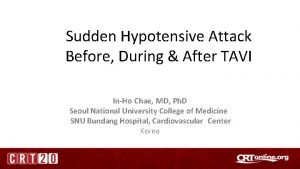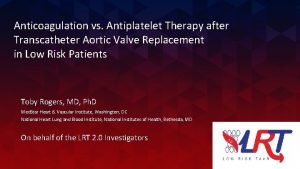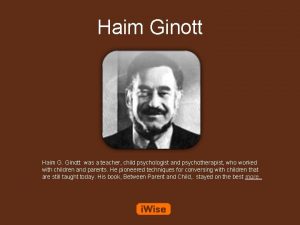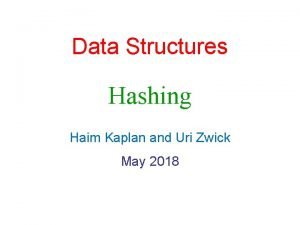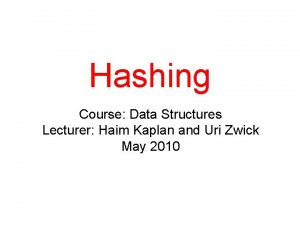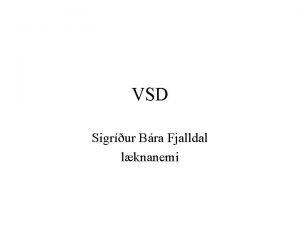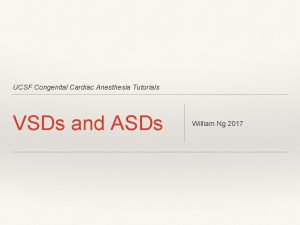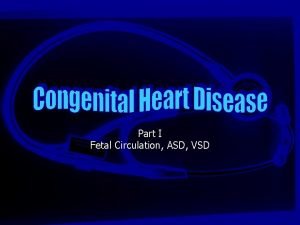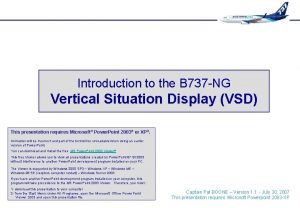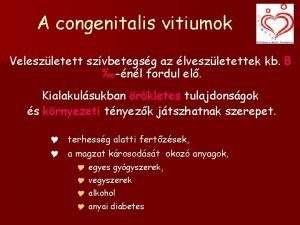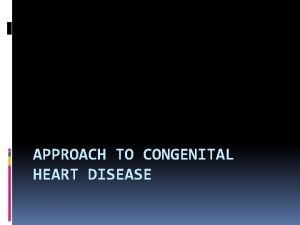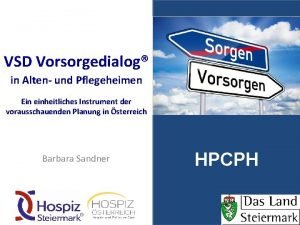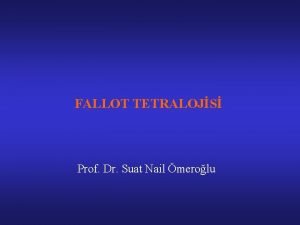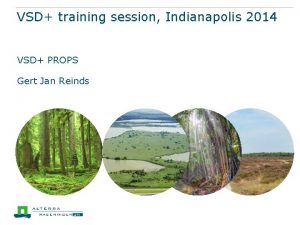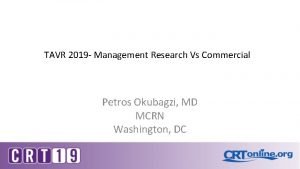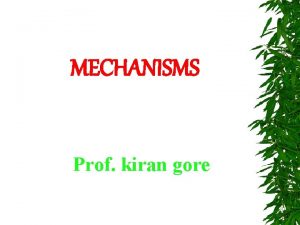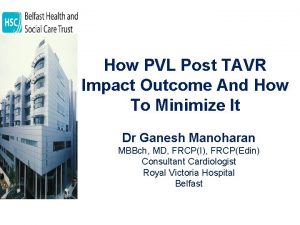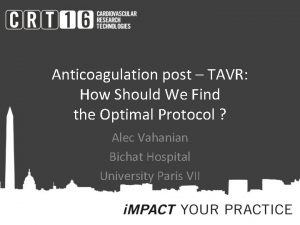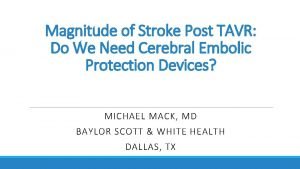VSD post TAVR Mechanisms Presentation and Management Haim

















- Slides: 17

VSD post TAVR: Mechanisms, Presentation and Management Haim Danenberg, MD Hadassah Hebrew University Medical Center Jerusalem, Israel

Haim Danenberg, MD Clinical proctor, Medtronic Consultant, 3 -D systems

Background • VSD may occur following trauma, cardiac surgery or post MI. • VSD is a rare complication of transcatheter aortic valve implantation (TAVI).

Background – VSD severity definition • Restrictive VSD • Size of the shunt: small (Qp/Qs ≤ 1. 4: 1) • Non significant left to right shunt (pulmonary-aortic systolic pressure of 0. 3) • Moderately restrictive VSD • Size of shunt: moderate (Qp/Qs of 1. 4 to 2. 2) • Pulmonary-aortic systolic pressure ratio < 0. 66. • Large or nonrestrictive VSD • Size of shunt: large shunt (Qp/Qs >2. 2) • Pulmonary-aortic systolic pressure ratio > 0. 66.

• 31 patients: • • 17 VSD 7 aortic root-RV fistula 3 trans-apical fistula 2 LV-RA (Gerbode) • 86% balloon-expandable • Estimated incidence 1. 5%. . Rojas et al. JACC Int 2016

• 18 VSD • 2 LV-RA (Gerbode) • Risk Factors: • • Severe annular calcification Oversizing Oval/assymetric annulus Ando et al. Heart, Lung and Circulation 2016 Post dilatation


Clinical presentation / therapy • Time of diagnosis: • Procedure-one year (median 7 days) • 12 (75%) dyspnea-overt heart failure m. VSD septal occluder • 4 (25%) asymptomatic • 4 not reported • 6 patients treated - percutaneous/surgical (1) closure

Study population • Three center, retrospective study of 400 patients who underwent TAVI in 2015. Age (years) 81 (39 -95) Gender Male 197 Female 203 Euroscore II 5. 58 ± 5. 76 Valve type Sapien (XT/S 3) 188 Core. Valve (classic/evolut) 197 Other/none 15 30 day mortality 2%

Results • Six patients (1. 5%) were subsequently diagnosed with a new VSD post-procedurally by transthoracic echocardiography. • All patients were hemodynamically stable with no clinical signs or symptoms. • No need for further intervention.

Post TAVR VSD patients Pt. Age Gender Severity of LVH Severity of AV calcification Device/ size VSD Location Severity of VSD (mm. Hg, mm) 1 83 F 12 mm Severe XT 26 Membranous Gradient = 140; VSD < 2 mm 2 87 F 14 mm Severe Core. V 26 Membranous Minimal; Restrictive 3 82 M 13 mm Moderate S 3 29 Membranous Gradient = 154 Qp/Qs 1. 1; VSD = 4 mm 4 81 M 12 mm Severe S 3 29 Membranous Gradient = 64 5 79 M 11 mm Severe Evolut 26 Muscular – near the apex Gradient = 66. 5 6 84 F 13 mm Severe Evolut 26 Muscular – near the apex Gradient = 88; VSD = 6 mm

Representative case: Membranous VSD

Representative case: Muscular VSD

Mechanism of Membranous VSD – Hypothesis • Overestimation of bioprosthetic valve size or highly calcific / narrow LVOT leading to high pressure exerted on the membranous part of the septum, potentially leading to its tearing and VSD formation. • Prevention: – Meticulous analysis of all imaging modalities enabling optimal choice of the most suitable valve and size. – Modeling / 3 -D printing of valve apparatus?

Mechanism of Muscular VSD – Hypothesis • Trauma to the interventricular septum caused by the stiff wire inserted to the left ventricle (in both of our cases Amplatz superstiff 1 cm). • Increased risk in hypertrophic, hypercontractile (usually found in elderly women) left ventricle. • Prevention: Extreme caution in small ventricles, wire insertion via pigtail catheter and the use of a dedicated pre-shaped stiff wires (Confida/Safari).

Post TAVR VSD: conclusions • VSD is a rare complication of TAVR with an incidence ranging 0. 5 -1. 5% • Most VSDs are of no hemodynamic significance, probably underdiagnosed and call for no special therapy. Large, hemodynamic significant VSDs may warrant defect closure • To minimize the risk of VSD formation it is recommended to: - Perform meticulous evaluation of the aortic valve annulus and LVOT with special focus on calcium dispersion - Accurate positioning of the bioprosthetic valve - Proper pre-shaping of the stiff wire or use of a dedicated stiff wire & deployment of wire via pigtail catheter

 Annular rupture tavr
Annular rupture tavr Tavr antiplatelet guidelines
Tavr antiplatelet guidelines Haim g ginott
Haim g ginott Uri wegman
Uri wegman Haim ginott congruent communication
Haim ginott congruent communication Haim kaplan
Haim kaplan Haim kaplan
Haim kaplan Vsd hjartagalli
Vsd hjartagalli Paramembranous vsd
Paramembranous vsd Type of vsd
Type of vsd Vsd boeing 737
Vsd boeing 737 Ductus botalli persistens
Ductus botalli persistens Vsd closure
Vsd closure Vsd
Vsd Vsd enterprise
Vsd enterprise Suat nail ömeroğlu
Suat nail ömeroğlu Post merger integration course
Post merger integration course Informed delivery campaign
Informed delivery campaign
